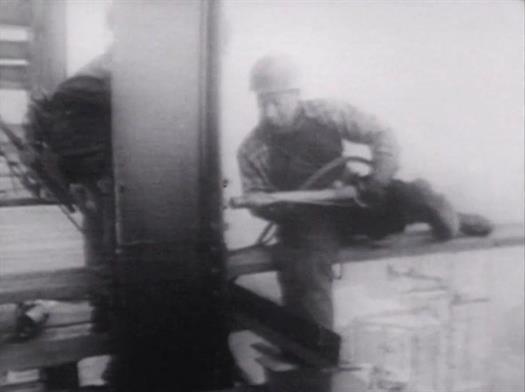
This week, Mohawk Ironworkers explores the connections between ironworkers and New York City.
Thomas Jock II, from Akwesasne explains that workers must travel for the work. Most of the large projects are found along the eastern coast of the U.S. in cities like Albany, New York and Boston. “Booming out” to the job, workers may spend months away from home and family; this is just one of the prices these men must pay for choosing this high paying, very high risk, occupation. Working in New York as a unionized ironworker, a person can earn in the neighbourhood of $2,000 a week.
The work week begins on Sunday, with the six-hour drive from Kahawa:ke or Akwesasne, in order to get to New Jersey for a night’s sleep. The work day begins at 4 a.m. in order to begin the commute to the job site in Manhattan. Several motels in the area recognize status cards, and try to accommodate as many ironworkers as they can with weekly rates. Rooming houses, small apartments and motels have replaced Little Caughnawaga in Brooklyn, New York, with families remaining in Kahnawa:ke.
This episode also covers the history of Mohawk ironworkers that began when they were hired in the 1880’s as unskilled workers on various building projects. Ever since, ironworkers have been traveling where the building boom takes them. Most building sites employ four or five workers from Kahnawa:ke and this brotherhood has helped to preserve the Kanien’keha (Mohawk) language as it’s often the language of choice for Mohawks on the job site.
This history also covers the collapse of the Quebec Bridge in 1907, an accident where 75 of the 86 workers building the bridge died, of which 33 were from Kahnawa:ke. Many of those who tragically died were not killed by the collapse itself, but rather were trapped by the wreckage at low tide and drowned when the tide came in. A number of memorials that have been built to commemorate these workers can be found in Kahnawa:ke.
This is one of the better episodes this season and far richer than many that have preceded it. The traditional documentary style of the program is tiring, particularly when we have seen some great storytelling in documentary formats using innovative techniques. I feel like I am back in grade school, which is a shame since so many of these stories could be presented in a way that engages the audience. I am hoping the directorial talents of Michelle Smith in next week’s episode bring some improvement.
Mohawk Ironworkers airs Tuesdays at 7 p.m. ET on APTN.
Read TV, eh Story